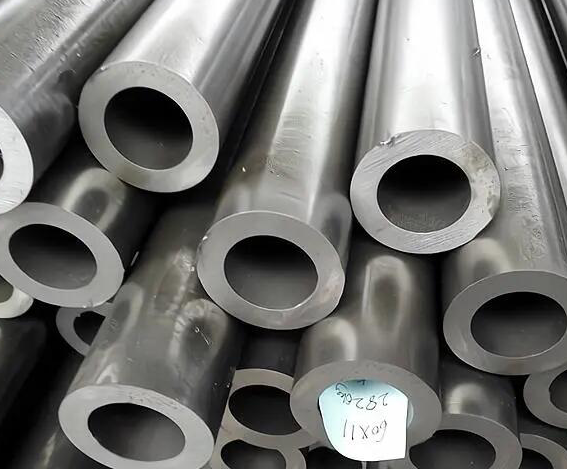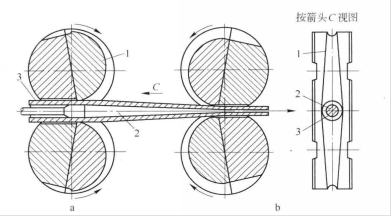
Advantages and Disadvantages of Cold Rolled Seamless Pipe
Seamless pipe (SMLS) cold processing methods include cold rolling, cold drawing and spinning, which are mainly used to produce small diameter, precision, thin wall and high strength pipes. Cold-rolled steel pipes have smooth surfaces, precise dimensions, good performance, various cross-sectional shapes, and high metal utilization. They are widely used in national defense industry, machinery, mining, chemical industry, electric power, agricultural machinery and other fields. The cold-rolled steel pipe process is developed on the basis of the cold-drawn steel pipe process. It solves the problems of small deformation, multiple passes, high metal consumption and poor deformation conditions of cold drawing.

Advantages of cold rolled seamless steel pipe:
The advantages of cold-rolled steel pipes are fast forming speed, high output, and no damage to the coating. It can be made into a variety of cross-section forms to adapt to the needs of use conditions; cold rolling can cause large plastic deformation of the steel, thereby improving the yield point of steel. details as follows:
1. High precision
Compared with ordinary steel pipes, the manufacturing process of cold-rolled seamless steel pipes is more refined and complex, which improves the accuracy of the steel pipes. The equipment and processes used in the manufacture of cold-rolled seamless steel pipes are also more complex, which can ensure the accuracy and quality of the steel pipes. Cold-rolled seamless steel pipes have high dimensional accuracy, uniform pipe wall thickness, and small deviations in pipe diameter and wall thickness. Therefore, cold-rolled seamless steel pipes are usually used where high-precision dimensions are required, such as in petrochemical, pressure vessel and other industries.
2. Good smoothness
The surface of cold-rolled seamless steel pipe is smooth and has no oxide layer, making it less prone to corrosion and other problems. Its surface quality is better than that of ordinary steel pipes. Cold-rolled seamless steel pipes are usually used where corrosion resistance is required, such as in chemical and petroleum industries. The surface smoothness of cold-rolled seamless steel pipes can also reduce the resistance of liquids and gases in the pipes and promote fluid transmission.
3. Mechanical properties
Because cold-rolled seamless steel pipes have been processed through multiple processes, their tensile strength and yield point are high, and their impact toughness is poor. Therefore, cold-rolled seamless steel pipes are usually used where high strength and hardness are required, such as machinery manufacturing, building structures and other industries.
4. Low cost
The cost of manufacturing cold-rolled seamless steel pipes is relatively low, and its use is more economical and practical in the long run. In some situations where large structures and high quality are required, the use of cold-rolled seamless steel pipes can reduce manufacturing and maintenance costs and improve economic benefits.
5. Application value
Cold-rolled seamless steel pipe has wide application value in engineering projects. Cold-rolled seamless steel pipes are widely used in petrochemical industry, pressure vessels, aerospace, nuclear energy, high-speed railways, machinery manufacturing and other fields due to their excellent properties such as high strength, high hardness and corrosion resistance. In some important and complex equipment, the application of cold-rolled seamless steel pipes is very important.
Disadvantages of cold-rolled seamless steel pipe:
1. Although there is no hot plastic compression during the forming process, there are still residual stresses in the section, which will inevitably affect the overall and local buckling characteristics of the steel;
2. Cold-rolled steel sections generally have open sections, which results in lower free torsional stiffness of the section. It is prone to torsion when subjected to bending and torsional buckling when subjected to pressure, and its torsional resistance is poor;
3. The wall thickness of cold-rolled formed steel is small, and there is no thickening at the corners where the plates are connected, so the ability to withstand localized concentrated loads is weak.
Cold rolled steel pipe process flow:
Cold-rolled seamless steel pipes are rolled through cold rolling mills and made through multiple processes such as pickling, phosphating, saponification, and lubrication.
The main advantage of cold-rolled steel pipe is its large section reduction rate, especially its strong wall reduction ability. For carbon steel, the section reduction rate in one rolling can reach 80% to 83%, and for alloy steel, it can reach 72% to 75%. Its main disadvantage is that tool replacement is difficult. In addition to being directly used to produce some cold-rolled pipes with higher precision, the cold rolling method is often used in conjunction with the cold drawing method to create cold drawn blanks. This can not only give full play to the wall-reducing ability of cold rolling, but also cleverly utilize the advantages of easy replacement of cold drawing tools, which is beneficial to improving productivity, expanding product production range and improving steel pipe surface quality.
Cold-rolled pipe production uses periodic cold-rolled pipe machines. The working characteristic of the periodic cold-rolled pipe mill is that the steel pipe and the mandrel do not move. The reciprocating movement of the frame drives the rolling of the steel pipe, and the variable cross-section profile is used to compress the rolled piece to achieve the purpose of diameter and wall reduction.

When the rolling mill and roll are in the original position a, the pass size is the largest (slightly larger than the outer diameter of the billet); when reaching the stroke limit position b, the pass size is slightly larger than the outer diameter of the finished product; before reaching position b, the pass size Minimum, which is equal to the outer diameter of the finished product. At the original position a, the pipe material is fed. Depending on the size of the rolling mill, the pipe material is fed 3 to 30 mm each time. At position b, turn over the pipe material, 60° to 90° each time, so that the roller can flatten the pipe wall when it returns. After returning to the original position a, the pipe material is fed in to start the next cycle of rolling. The pipe material is rolled repeatedly in this way, and finally the cold-rolled steel pipe of the required size is rolled out.
Read more: Choose seamless tubes: Hot rolled vs. Cold rolled


